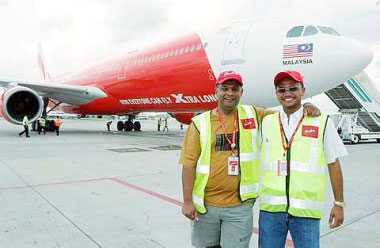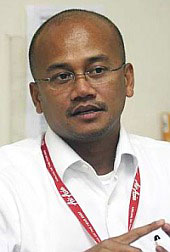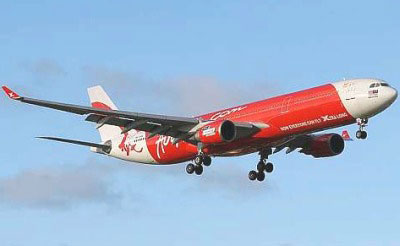AirAsia unleashes its X-factor
27 September, 2008
By CECILIA KOK
Barely a year since the launch of Malaysia's no frills long haul carrier, AirAsia X has firmly carved a seat for itself in the ever competitive and increasingly challenging market.
IN the city of Gold Coast in Australia, Kuala Lumpur has suddenly become the talk of the town. That is because a new budget airline has emerged in the Aussie city and painted it red with advertisements for "cheap" flights to KL.
AirAsia X Sdn Bhd's aggressive marketing campaign has resulted in the smashing success of its Gold Coast-KL route that was launched last November. The fact that most of the airline's Gold Coast passengers are first-timers to the Southeast Asian region is testament to the success of the route.

AirAsia group CEO Tony Fernandes and AirAsia X CEO Azran Osman-Rani.
At the same time, an increasing number of Malaysians are choosing Gold Coast as their favourite holiday destination, as evidenced by AirAsia X's recent survey that shows 67% of its Malaysian passengers are first-timers to Gold Coast.
The Australian city is one of the two destinations to which AirAsia X flies currently from its hub at the low-cost carrier terminal (LCCT) in Sepang.
Hangzhou, China, was added to the airline's stable early this year, and business for the route is fast picking up, according to AirAsia X chief executive officer Azran Osman-Rani.
"We attribute this to our pricing strategy that has enabled more people the affordability to travel long haul," he explains.
Low-cost long-haul, as the business model for AirAsia X, is an extension of AirAsia Bhd's success with its low-cost short-haul model.
While both airlines share the same brand, uniform and logo, they are maintained as separate entities, with AirAsia X focusing on destinations beyond a four-hour radius from LCCT and AirAsia focusing on the Asian region within a four-hour radius from its KL hub.
Separate entities that belong
AirAsia group founder Datuk Tony Fernandes says the move to keep the two airlines as separate entities is part of a strategy to ensure the best use of capital for the group and the continuous profitability of its Main Board-listed short-haul business.
"Being an unproven model, the low-cost, long-haul business is rather risky. But it is a feasible business with tremendous growth opportunities, hence it qualifies for us to put our money on it," Fernandes explains.
Fernandes and a group of individual investors, including Datuk Kamaruddin Meranun and Datuk Seri Kalimullah Hassan, collectively hold a 48% stake in AirAsia X.

Fernandes: We fly to where others dare not fly or have given up.
The other prominent shareholders in AirAsia X include British billionaire Richard Branson's Virgin Group, with a 16% stake; Japanese conglomerate ORIX Corp with 10%; and Bahrain-based Manara Infrastructure Fund with 10%. AirAsia holds the remaining 16% stake.
Spreading its wings
At the recent World Low Cost Airline Congress in London, AirAsia X was named the World's Best New Airline for 2008.
Azran, the man anointed to take AirAsia X to greater heights, shares: "There is clear synergy between AirAsia and AirAsia X. The latter is positioned to bring in passengers from the world over to KL either for a stay or stopover to get connected to the rest of Asia via our sister carrier."
With this vision in mind, both AirAsia X and AirAsia are continuously expanding their network.
Come November, AirAsia X would have roped in two new Australian destinations, namely Perth and Melbourne.
On top of that, it plans to increase its frequency on the Gold Coast-KL route from the current four times a week to daily flights by the end of the year, while next year will see the launch of the highly anticipated direct flights to London and some major cities in Japan.
AirAsia X has also set its eyes on the South Korean, Northern Indian and the Middle Eastern markets.

Azran: Clear synergy between AirAsia and AirAsia X.
According to Azran, the long-haul budget carrier has also received enquiries from some European and New Zealand airports for the possibility of launching connections with KL.
AirAsia, on the other hand, has on its list 106 new routes to be added to its current list of 60 over the next few years.
Acknowledging that the current market condition presents a challenging environment for many businesses, Fernandes, who is also the CEO of AirAsia, says: "Our group thrives on innovation in disruptive market by taking the opportunities to fly to where others dare not fly or have given up."
Virgin Management Asia-Pacific CEO and Head of Aviation David Baxby is confident that AirAsia's strategy in expanding its network could provide the group good prospects for the long term.
He says: "Over the years, AirAsia has shown success in being a visionary company that sees a new market and believes in its potential when others could not see it."
Take its routes to Bandung in Indonesia, and Hainan in China. Many were sceptical when AirAsia started flying there. Today, Bandung and Hainan are among the company's fastest-growing markets.
Going against the tide
Another contrarian approach by AirAsia group that has raised eyebrows is the group's order of 200 new planes from Airbus in spite of the slowing global economy.
"Acquiring new planes is necessary to support the growth of our business on top of us innovating on new routes," Azran explains.
"If we have not placed our orders earlier, we would not be able to get the planes in time to ply the new routes," he adds.
The group's new plane orders include 25 Airbus 330 for its long-haul routes, two of which will be delivered in the next two months in time for the launch of AirAsia X's new destinations to Perth and Melbourne. Three of the units will be delivered next year and 15 over the subsequent three years.
The remaining new orders of 175 planes are for the Airbus A320 model, 60 of which will be delivered over the next five years, for the short-haul business.

Analysts are concerned with AirAsia's expansionary mode in the midst of what they view as a shrinking market condition.
"Expanding where demand is falling is a major concern because there is a risk of its ticket sales not matching its capacity growth. Fact is, share prices move according to market expectations, and the current market expectation is rather negative," says an analyst.
However, some analysts do acknowledge that AirAsia's strategy has well positioned the group to emerge as one the strongest aviation players once the market condition improves.
"We defy logic. Our view is that people still want to travel in a down market, and they are most likely going to trade down in order to save more money," Fernandes says.
"Even if our regular customers may cut down on their travel with us, we will gain some new customers who previously use premium flights," he adds.
The migration of passengers who are price-sensitive has enabled AirAsia group to gain new ground. While the group's focus has always been on the non-business, leisure sector, it has, of late, seen the increase of business travellers on its flights.
Azran opines that the current environment may hurt airlines in high-cost positions, but AirAsia group is set to benefit from the slowing economy because of its ability to offer comparatively lower fares.
AirAsia believes that most passengers do not have loyalty to any particular brand because their choices depend on ticket prices.
"Therefore, we believe demand for budget travel is here to stay," Azran says, adding that AirAsia X is currently operating on a positive cash flow because it has already sold tickets for travelling period of up to the middle of next year.
Survival of the fittest
The first half of this year, during which crude oil prices were rising to record levels, was a turbulent period for the aviation industry as a whole. Several low-cost carriers (LCCs) have since ceased operations because of their inability to cope with the high fuel prices. This list includes Hong Kong's Oasis, Indonesia's Adam Air and Thailand's One-Two-Go.
The closure of these airlines is boost to AirAsia's market share and enhances its position as the ultimate leader in the region's low-cost sector, says a local analyst.
Bahrain-based Perigon Advisory, which manages the Manara Infrastructure Fund, is confident that AirAsia group has the marketing know-how and X-factor to capitalise on such opportunities that arise from its competitors falling out of the game.
"The group has been able to take its business to successful level because it has a deep understanding and discipline in following its low-cost model," says Perigon Advisory partner Michael Rodriguez.
AirAsia has managed to ride through the stormy period, with a net profit of RM9.42mil for the second-quarter (2Q) ended June 30, 2008.
The figure represents a 95% year-on-year (y-o-y) decline, mainly due to its high translation loss of RM77mil resulting from the weakened ringgit.
The 65% y-o-y increase in its unit fuel costs from US$86.20 per barrel to US$142.5 per barrel during the period had also eaten into AirAsia's profit.
On a positive note, AirAsia actually recorded a rise in its passenger numbers by 20% y-o-y from 2.3 million to 2.8 million for 2Q08, despite its average fares rising 16% y-o-y from RM170 to RM198.
Its revenue for the period under review rose an impressive 41% y-o-y from RM432mil to RM608mil.
Nevertheless, the high fuel prices remain a major concern for most investors because fuel represents around 40% to 50% of AirAsia's cost, and that element alone can determine whether the company makes or loses money, an analyst points out.
To this, Fernandes says: "We always find ways to adapt to the high-cost environment. We are continuously working on improving our efficiency, although we believe we are already operating at very efficient levels".
He explains that the group's employment of new planes which are more fuel-efficient for all its routes helps mitigate the effects of rising fuel costs, and its simple business model helps keep its non-fuel costs at minimum levels.
These are factors that have provided AirAsia group the edge over its major rivals, some of which are still using inefficient planes that are as old as 10 to 15 years and operate on a complicated system that requires high maintenance.
In addition, the sharing of resources, such as the online booking platform and cabin crew, between AirAsia and AirAsia X has enabled the group to operate on high economies of scale. This is more to the benefit of AirAsia X, which according to Azran, is on track to achieve profitability by next year.
Azran also reveals that the group has hedged 100% of its fuel at US$115 per barrel for up to the end of the year.
The stumbling block
Hence, come down market and high fuel cost, AirAsia group will go on with its expansionary plan. The only complaint that the group has is its overcrowded main hub at LCCT, which Fernandes claims as posing a real resistance to the group's growth.
"We have built a world-class business that is growing rapidly, but the infrastructure at LCCT is not catching up," Fernandes explains.
"Airport is an urgent issue to us because it is a crucial element for us to expand our connectivity. We cannot be successful if we do not have better airport infrastructure," he adds.
The LCCT in Sepang is currently undergoing an extension to increase its annual passenger capacity from the present 10 million to 15 million.
Scheduled for completion in March next year, the extension is to cater to the growing numbers of budget carrier passengers.
But based on AirAsia group's expected growth rate plus that of other low-cost carriers that stop at LCCT, the newly installed capacity will again be fully utilised within the next two years.
A new LCCT terminal, with an annual capacity of 30 million, has been proposed by Malaysia Airport Holdings Bhd.
Not knowing when exactly the new terminal will be ready, Azran says AirAsia group cannot afford to wait for the new LCCT terminal to be ready.
"We project that our passenger number would to reach 28 million by 2015. If our KL hub cannot cope with our passenger numbers, we may have to end up stopping at other regional airports, which will then be a loss to our country," Azran explains.
Fernandes says, "the growth of the low-cost airline sector in Malaysia hinges on the support of MAHB, not only in terms of the infrastructure it provides, but also the way it imposes the airport charges."
According to Fernandes, AirAsia group currently pays higher airport charges in Malaysia compared with the fees that it pays to its other hubs in foreign land, on top of having to endure the under-capacity of the LCCT in Sepang.
Fernandes sees the future of Malaysia's aviation industry as underpinned by carriers that offer low fares. He points to national carrier Malaysia Airlines Bhd (MAS)'s "Everyday Low Fare" campaign to support his argument.
"It is an acknowledgment that low-cost model works and can bring in the numbers," he says.
On whether the various promotional campaign and branding strategies launched by other airlines are a major threat to AirAsia group, Fernandes says: "We do not focus on what others do because we believe in our own strategy. And as far as we are concerned, our business has been growing at a healthy pace."
But what both Fernandes and Azran seek is a level-playing field for AirAsia group. For instance, to be allowed to fly to where the national carrier flies.
Despite having its flight destinations and frequencies severely limited by the Malaysian government under a protectionism policy for MAS in the early days of its operations, AirAsia has over the years built an amazingly strong brand presence in many international markets.
Many observers have attributed AirAsia's success to the leadership of Fernandes.
"Culture eats strategy for lunch"
A great strategy will not be effective if there is no team work, says H. Dale Ichida, the managing director for aviation and alternative investments for ORIX Corp.
"AirAsia has the right corporate culture to grow. There is no bureaucracy and Fernandes is easily accessible to his staff members, hence enabling important discussions to take place on the spot. In a competitive environment, corporate bureaucracy can impede growth," Ichida says.
Virgin group's Baxby and Perigon Advisory's Rodriguez also believe that the management philosophy practised by AirAsia group is the key element to its success.
"Fernandes has used his entrepreneurial skills, something which is intangible, to steer the company out of difficult times before, and we believe his management philosophy will continue to promote the growth of the group," Rodriguez shares.
This article is a verbatim copy of the original article from The Star.